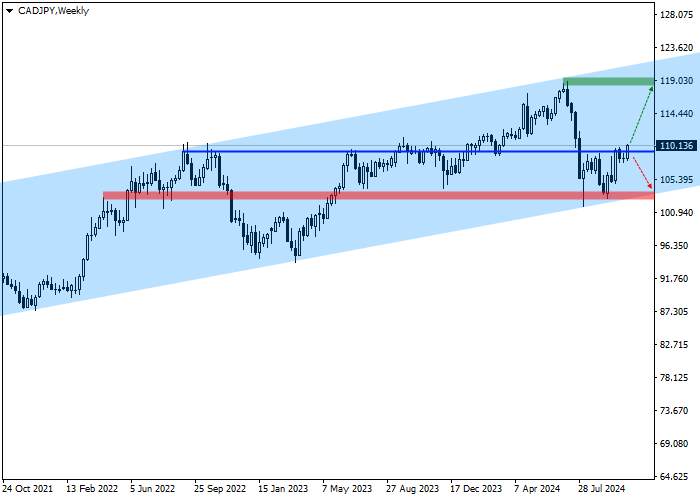CAD/JPY: quarterly review

Today, we present you a mid-term investment overview of the CAD/JPY pair.
Despite the improvements compared to the middle of the year, the situation in the Canadian economy remains quite tense: the consumer price index (CPI), under the influence of a fairly high interest rate, decreased by 0.4% in September, which led to an annual correction from 2.0% to 1.6%, and the average inflation rate, which is used more often in the country, was 2.3%. The core indicator, which excludes food and fuel prices from calculations, remained unchanged in September after a 0.1% decrease in the previous month, leading to an increase in growth rates to 1.6% YoY. The labor market also looks much more confident: according to the September report, the unemployment rate in Canada fell to 6.5% from 6.6% a month earlier against the background of a significant influx of 46.7 thousand people employed in key sectors. In addition, the Ivey general business activity index (PMI) rose from 48.2 points to 53.1 points in September. Thus, the current economic situation allows the Bank of Canada to consider continuing to reduce interest rates: today at 16:30 (GMT 2), the next meeting of the regulator will be held, during which the cost of borrowing can be adjusted from 4.25% to 3.75%.
At the same time, after an active strengthening at the end of the summer, a significant part of which was due to interventions by the Bank of Japan (BoJ), the yen has now lost most of its positions. The interest rate, the hope of an increase in which stimulated investors to invest in the Japanese currency, was maintained at 0.25%, and the probability of its further growth in the near future is low: representatives of the Japanese regulator have repeatedly pointed out that when choosing monetary policy, they primarily focus on the decisions of the US Federal Reserve, where the cost of borrowing has recently been actively decreasing. Other key indicators are also of concern, in particular, the state of the engineering sector: basic orders in the industry fell by 1.9% in August after a correction of 0.1% earlier, and YoY, the indicator declined by 3.4% after an increase of 8.7% in the previous period.
In addition to the underlying fundamental factors, the continued growth of the CAD/JPY pair is confirmed by technical indicators: an ascending channel with boundaries of 122.00–102.50 is formed on the W1 chart, within which the price has reversed around at the support line and is preparing to continue the uptrend.

Since the price has been keeping within the boundaries of the above channel for more than two years, most factors indicate a possible continuation of the uptrend with an increase towards the resistance line of 122.00.
Key levels can be seen on the D1 chart.

As you can see on the chart, the upward wave is developing within the framework of the "head and shoulders" reversal pattern with the "neck" line at 109.50, and now the price is trying to stay above this level, the probability of which is quite high.
At the 103.80 mark, which coincides with the support line of the ascending channel, there is a zone of cancellation of the buy signal; if it is reached, the ascending scenario will be canceled or noticeably delayed in time, and long positions should be liquidated.
In the area of the maximum of July 11 at 118.80, there is a target zone; if the price reaches it, one should take profits on open long positions.
In more detail, trade entry levels can be evaluated on the H4 chart.

The trade entry level is located at 109.50, and the entry signal was received this morning. Technically, a breakdown of the "neck" line of the pattern was implemented, after which the probability of continued growth increased significantly, and the upward scenario can now be implemented. Given the presence of quotes above the "neck" line of the pattern, buy positions can be formed at the current price exceeding 109.50.
Given the average daily volatility in the CAD/JPY pair over the past month, which is 590.4 points, the price movement to the target zone of 118.80 may take about 45 trading sessions, however, with increased dynamics, this time may be reduced to 34 trading days.
Disclaimer: The content above represents only the views of the author or guest. It does not represent any views or positions of FOLLOWME and does not mean that FOLLOWME agrees with its statement or description, nor does it constitute any investment advice. For all actions taken by visitors based on information provided by the FOLLOWME community, the community does not assume any form of liability unless otherwise expressly promised in writing.
FOLLOWME Trading Community Website: https://www.followme.com


Hot
No comment on record. Start new comment.